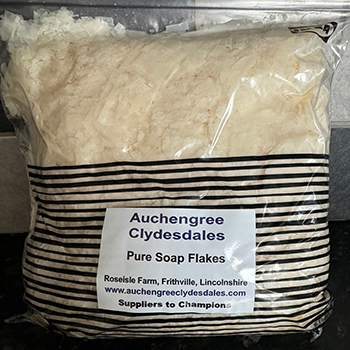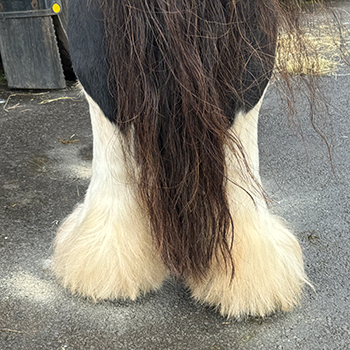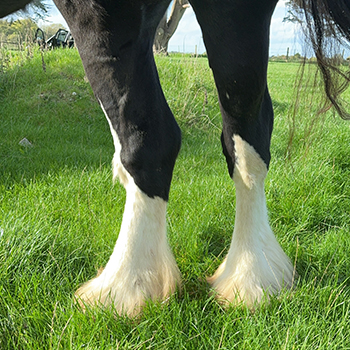I used to use fairy liquid and copious amounts of apple shampoo to attempt to clean my horses’ feather; this used to take hours and hours of washing over several days to achieve a satisfactory clean feather but it was never quite enough. This year I took the advice of a fellow shire horse owner and tried soap flakes, soft soap and wood flour (all supplied by Matthew Burks) and I have now been converted! Not only are these products time saving they are also far easier to use and give a far better result.

To begin place a large cupped handful of soap flakes into a bucket of hot water and allow them to dissolve. Using warm water, if possible, soak the feather until every strand is drenched then sponge the soap mix onto the legs and allow to thoroughly soak in. Using a nail brush or stiff body brush, scrub the feathers and remove as much surface mud as possible. Then use fingers to scrub nearer to the skin and remove all the bits of grease and skin build up. Don’t just scrub the ends of the feather as the deeper dirt will show up in the arena, believe me! Once you have scrubbed the worst leave to stand for 15 minutes before rinsing away the soap and water.
One of my earliest rookie errors was only scrubbing the feathers from top to bottom and not lifting them and scrubbing upwards – I’d thought Louie’s legs looked amazing until I watched the videos back and realised that as he trotted away from the camera his leg action lifted his feathers and the underside could be clearly seen by all – and yes they looked as though I hadn’t touched them!! Lesson learned.
Once you have rinsed off the soap and washed away the dirt it remains to be seen whether you need to repeat this process or not. The next step is to apply soft soap. This can be gently rubbed into the feathers to clean even further but it also separates each strand of hair so that when dry the feathers appear fluffy instead of clumpy. Again leave on for 15 minutes and then rinse off.


Towel dry the feathers as much as possible then apply wood flour. This aids water absorption but also helps to whiten the feather. Leave on for as long as possible and then comb through to remove excess flour. Talc or whitening powder can be used with the wood flour to help make the feather appear whiter than white.
Throughout the winter it is a good idea to use a mix of pig oil and sulphur to help keep dirt and mites away from the skin. By keeping the skin in good condition the follicles stay healthy and this encourages stronger hair growth and therefore fuller feather.

